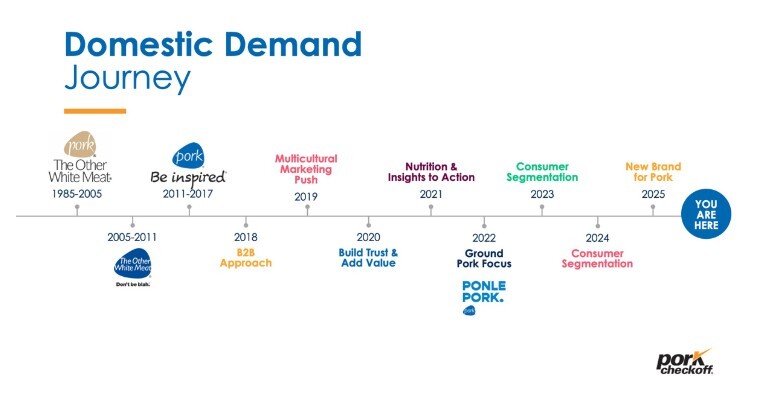



'Taste What Pork Can Do' launched as new US pork marketing campaign
The National Pork Board creates transformational moment to radically reposition itself in domestic marketThe US National Pork Board (NPB) has launched an ambitious new domestic marketing campaign aimed at strengthening consumer demand and reshaping the perception of pork in the US market.
Dr. David Newman, Senior Vice President of Market Growth at the National Pork Board, has been at the forefront of this transformation. He spoke to The Pig Site’s Sarah Mikesell shortly after the National Pork Industry Forum, which was held in Orlando, Florida, USA.
"For the last 25 to 35 years, we have had tremendous export growth in this country. However, with the challenges domestically on the production side over the last five years, our producers and board of directors have prioritized that same type of emphasis on the domestic market," said Newman. “We did segmentation research to really better understand who our consumer is and what drives them, and that led us to this decision about launching a new domestic marketing campaign.”
Shift in focus
The pork industry’s renewed domestic focus is not just about adapting to changing market conditions; it is about capitalizing on a massive opportunity. Annually, Americans consume around 20 billion pounds of pork domestically, compared to approximately 8 billion pounds exported internationally. Despite this, domestic marketing has not received the same level of attention as exports—until now.
A major driver behind this shift is comprehensive consumer research conducted by the NPB.
"When you do the consumer segmentation work – it’s a very robust research process that we went through – it really helps us identify the who, when, what, where targets that we think about for our future consumer,” said Dr. Newman. “Ultimately, that’s what led us to making this decision to launch, but more importantly, to strategically focus on who that consumer is, and how we can drive demand within the segments.”
This data-driven approach allows the industry to ensure that marketing efforts are effective, efficient and impactful.
A data-driven strategy
The National Pork Board’s consumer research revealed key insights that shaped the new marketing strategy. One of the standout findings is that younger generations—Millennials and Gen Z—are crucial to the future of pork consumption. These groups prioritize taste, flavor, versatility and convenience, which became the foundation for the new campaign.
The new campaign’s tagline, "Taste What Pork Can Do." is described by Dr. Newman as "an unapologetic rally cry for our producers that was built on consumer data. It resonates very well with Gen Z and Millennials, the people we are trying to position this product to."
Unlike previous marketing efforts—most notably the classic "The Other White Meat" campaign—this initiative is built on a more nuanced understanding of consumer behavior.
"This is a different reposition built on data. We have never done a consumer segmentation this robust," Newman noted. “And there is a very intentional process here to think about both processed and fresh pork in the strategy.”

Industry-wide collaboration
The success of the campaign depends on a unified effort across the pork industry. Producers, state pork associations, packer processors and retailers are all integral to its implementation. Newman describes the strategy as creating a "halo effect," ensuring that every segment of the value chain contributes to increasing domestic demand.
"What we do at the National Pork Board represents 60,000 pig farmers," said Newman. "To create consumer product pull-through in the marketplace, we’ve got to work with the value chain. That means working with packer processors, retailers, and food service companies, and engaging one-on-one with consumers."
State pork associations will also play a crucial role, acting as the "boots on the ground" to facilitate state-level activations and support the national campaign.
"We have 42 state pork associations, often in states with a lot of pigs but not a lot of people. They ensure our strategy reaches key retail and market areas," Newman explained.
Shift to digital approach
A major departure from past marketing efforts is the campaign’s emphasis on digital media. Newman noted that consumer habits have shifted, necessitating a more modern approach.
"This is going to be a mostly digital campaign because that’s how the future consumer works—off of this thing right here," he said, referring to a smartphone.
While digital media will be the primary avenue, the campaign will also include retail store activations, print materials and in-market collaborations. Understanding consumer habits and strategically targeting key markets will make the campaign more efficient.
"Eighty percent of pork consumption in this country is done in less than 20 states," said Newman. "Very large markets like California, Texas, Florida and New York account for one-third of all US pork consumption. We always say, ‘you’ve got to fish where the fish are.’"
The Road Ahead
After two years of research and strategic development, the campaign is set for a full-scale launch in May 2025. A soft launch took place at the National Pork Industry Forum, where producers were introduced to the brand strategy and tagline.
"Now it’s activation time. It’s time to introduce this to the broader world," Newman said enthusiastically.
At its core, the initiative aims to drive consumer engagement and reposition pork as a versatile, flavorful and convenient protein choice.
"Consumers do like our product. It’s about positioning it in a way that we can celebrate it beyond special occasions—moving into everyday meals," Newman stated.
The Bottom Line
For the National Pork Board and the pork industry at large, the new campaign represents more than just a marketing initiative; it’s a transformational shift in how pork is perceived and consumed in the US. By leveraging cutting-edge consumer research, digital marketing strategies, and industry-wide collaboration, the campaign aims to secure pork’s place on more American dinner tables.
"At the end of the day, this is really simple," Newman concluded. "It’s about getting more people to eat more pork. It's really a simple concept; it's just very difficult to get there, to change the mind of consumers. But we’re ready for it, and we’re excited to go after it."







